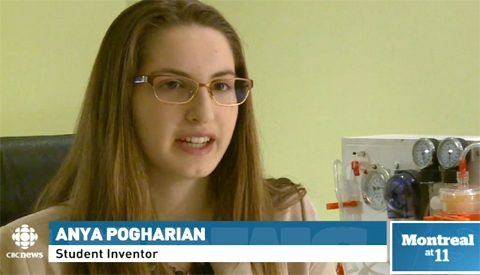cbc.ca: Pogharian said she was inspired by volunteering at a hospital, seeing effect of dialysis on patients Seventeen-year-old Anya Pogharian’s high school science project could end up changing the way dialysis care is delivered After poring over online dialysis machine owner’s manuals, she developed a new prototype using simple technology. While machines currently cost about $30,000, hers would cost just $500 — making it more affordable for people to buy and have at home.
 Pogharian was inspired by volunteering at a hospital dialysis unit. When she was assigned a high school science project, she chose to work on a new kind of dialysis unit. She spent 300 hours on her invention — well above and beyond the mandatory 10 hours.
Pogharian was inspired by volunteering at a hospital dialysis unit. When she was assigned a high school science project, she chose to work on a new kind of dialysis unit. She spent 300 hours on her invention — well above and beyond the mandatory 10 hours.
Dialysis is the process of cleaning waste from the blood. It's typically used for people who have kidney disease. The treatment takes about four hours a couple times per week.
Pogharian said she wanted to find a way to improve the procedure, which can be hard on patients.
“It takes a lot of energy out of them,” said Pogharian. “They’re very tired after a dialysis treatment.”
"You wouldn't have to make your way to the hospital, which is a problem for a lot of patients. It's not necessarily easy to make your way to the hospital three times a week, especially it you have limited mobility," she said.
Testing it out
Her project has earned her a slew of scholarships and awards. Now, Héma-Québec has offered her a summer internship, to try out her invention with real blood.
"All the population will benefit from that kind of instrument that will reduce medical care cost, hospitalization stays. Basically, it's a great idea," said Louis Thibault, director of applied research at Héma-Québec.
Pogharian said she hopes one day, her invention will be used overseas.
"Ten per cent of patients living in India and Pakistan who need the treatment can't afford it or can't have it in any way. It's not accessible. So that motivated me."
But Pogharian says she’s focusing on doing well on her CEGEP midterm exams.











